Immigration is Changing the Face of Suburban America
Immigration is Changing the Face of Suburban America
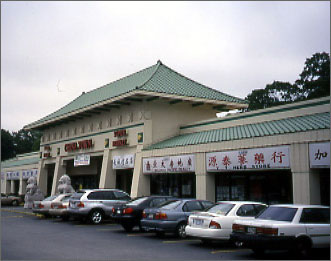
ATLANTA: Globalization and the offshoring of jobs have brought about the decline of many old industrial towns in the US heartland. At the same time, however, globalization has also brought migrants from different corners of the world to help revive other areas. Atlanta, in America's Deep South, offers a good example of the positive effects of job migration. In suburban counties of metropolitan Atlanta, the low taxes, low-cost real estate, and good schools that once attracted businesses like General Motors are now drawing new immigrants and foreign business. Although immigrants have historically settled near their urban workplaces, in Atlanta many new immigrants are passing up city life and choosing to settle in the suburbs of DeKalb County. This new pattern of settlement is dramatically changing the face of American suburbia and aiding in the economic revitalization of cities like Atlanta.
People from places such as Mexico, China, Vietnam, Nigeria, and Bosnia are now calling the Atlanta metropolitan area home. These new immigrants range from venture capitalists to small business owners to service workers, all looking for opportunities in Atlanta's booming economy.
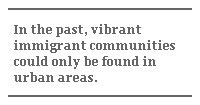
In the past, vibrant immigrant communities could only be found in urban areas. When the first large waves of immigration began in the 1800s, new arrivals congregated in city centers where they could rely upon networks of mutual assistance. In densely populated and fairly homogeneous neighborhoods, people 'fresh off the boat' could solicit the help of their compatriots in seeking jobs and negotiating the American legal and social systems. Newcomers could also find familiarity and comfort among people of their own linguistic, cultural, and religious background. Enclaves known as 'Little Italy' or 'Chinatown' developed over time into distinctive features of many American cities.
Today, the labor markets in the American Northeast and Midwest, which absorbed earlier waves of immigrants, are saturated. While New York, Los Angeles, and San Francisco - the largest points of entry in 2000 -; still have vibrant ethnic enclaves, first-generation immigrants looking for new economic opportunities are turning to cities that have not historically received large numbers of immigrants. Through word of mouth, in the 1980s Mexican immigrants displaced by the oil bust in Texas and Louisiana found work in Georgia, working in construction and low-end service jobs created as many northern companies re-located. Lured by aggressive state and local marketing groups, these companies found cheaper non-union labor, lower construction costs for infrastructure, few government regulations, and higher standards of living for relocated workers from more expensive northern cities.
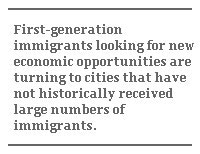
The relocations created a steady demand for entry-level service workers in every industry, from fast food to landscaping. Working-class immigrants have made the most of these opportunities, filling a real need for labor. For white-collar immigrants, as well, Atlanta's growth has meant more professional-level jobs and research positions at institutions like Coca-Cola or the Centers for Disease Control. These middle-class immigrants are more likely to locate in the new suburban developments further outside the city than in DeKalb's suburban ethnic enclaves. However, their growing numbers have created numerous ethnic immigrant community organizations, from religious institutions to community centers.
While economic opportunities are still more prevalent in urban areas, immigrants are forming residential communities outside of major cities. Many immigrants coming to Georgia are not settling in Atlanta proper, but rather in its adjacent suburbs. These suburbs first sprang up in the 1950s as working-class white enclaves for the employees of General Motors and other industrial plants. Industrial workers were looking to own their own homes, and higher wages made that possible.
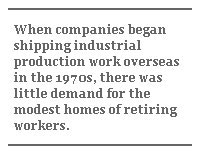
When companies began shipping industrial production work overseas in the 1970s, though, there was little demand for the modest homes of retiring workers. As stores left and apartment demand dropped in the 1980s, landlords began to rent to immigrants. Those moving to Atlanta discovered cheap rents and relatively easy entry to these abandoned suburbs, now located within the I-285 beltway that encircles the city. Immigrant entrepreneurs saw the demand for new shopping centers, as growing affluence from the emerging immigrant middle class created the need for ethnic restaurants and markets. Later, the demand for ethnic goods spread to the general metropolitan population seeking unique places to shop and dine.
The success of the immigrant influx may have been just what Atlanta needed. Until the 1990s, the city';s claims of internationalism were based more on civic promotion campaigns than reality. In the early 1970s the Atlanta Chamber of Commerce launched the slogan, "Atlanta: the World's Next Great International City". Although elites in other American cities laughed at this boosterism, Atlanta's efforts enabled it to land the 1996 Summer Olympic Games. As the international press turned their gaze on Atlanta, civic leaders bristled at criticisms comparing Atlanta to more "international" previous Olympic host cities, especially Barcelona. Critics charged that Atlanta's rapid development and lack of regard for historic structures had created a soulless landscape lacking the charm and character of other American cities like New York, San Francisco, or New Orleans, all characterized by their urban ethnic immigrant enclaves. Today, however, Atlanta has attracted the same diversity, but in a different form - suburban enclaves made up of a mix of ethnic groups.
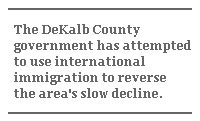
The grassroots success of small-scale immigrant entrepreneurs in redeveloping shopping centers and apartment complexes piqued the interest of Atlanta's leaders, who saw the potential of immigrant communities to serve as a catalyst for metro-wide economic development. Marketing the six-mile long Buford Highway corridor as ";The International Village" to reflect the ethnic mix of Mexican, Central American, Chinese, and Korean settlements, the DeKalb County government has attempted to use international immigration to reverse the area's slow decline. As the successes of the area's 700 ethnically owned businesses have increased and the scale of projects grown, it has attracted larger international investments. Numerous banks and supermarkets have jumped in to serve the growing Mexican population and the diverse Asian community. The International Village at Chamblee, a $72 million project, is a 500,000 square-foot mixed-use center featuring shops, offices, restaurants, and a hotel.
Most recently, the Atlanta metro region is vying to become home to the new Free Trade Area of the Americas (FTAA), a planned 34-nation free trading group stretching from Canada to Chile. Local government and business leaders estimate that the FTAA would create 11,000 new jobs with a $500 million annual economic impact on the Atlanta region. Local officials believe that the International Village location represents the ideal of what may be achieved through global trade and immigration.
As other second-destination cities turn to Atlanta for advice on how to attract foreign investment and spur local economies, it remains to be seen whether the success of the DeKalb County suburbs can be repeated elsewhere. Some immigrants have expressed concern that their local communities will become commodified, stereotypical ethnic villages designed to entertain suburban residents instead of vibrant enclaves focused on local residents. And other newly ethnic suburban areas have failed to attract a similar level of international and local investment. Many immigrants trapped in low-wage jobs can afford cheap suburban living spaces, but lack the spending power to be seen as investment-worthy consumers. Still, Atlanta's success shows that as immigrants move to second-city destinations and settle outside metropolitan areas, their arrival can bring increased international attention and investment to an entire region.
William G. Holt, III is a PhD Candidate in the Department of Sociology at Yale University. This essay is based on his research in the Atlanta metropolitan area.